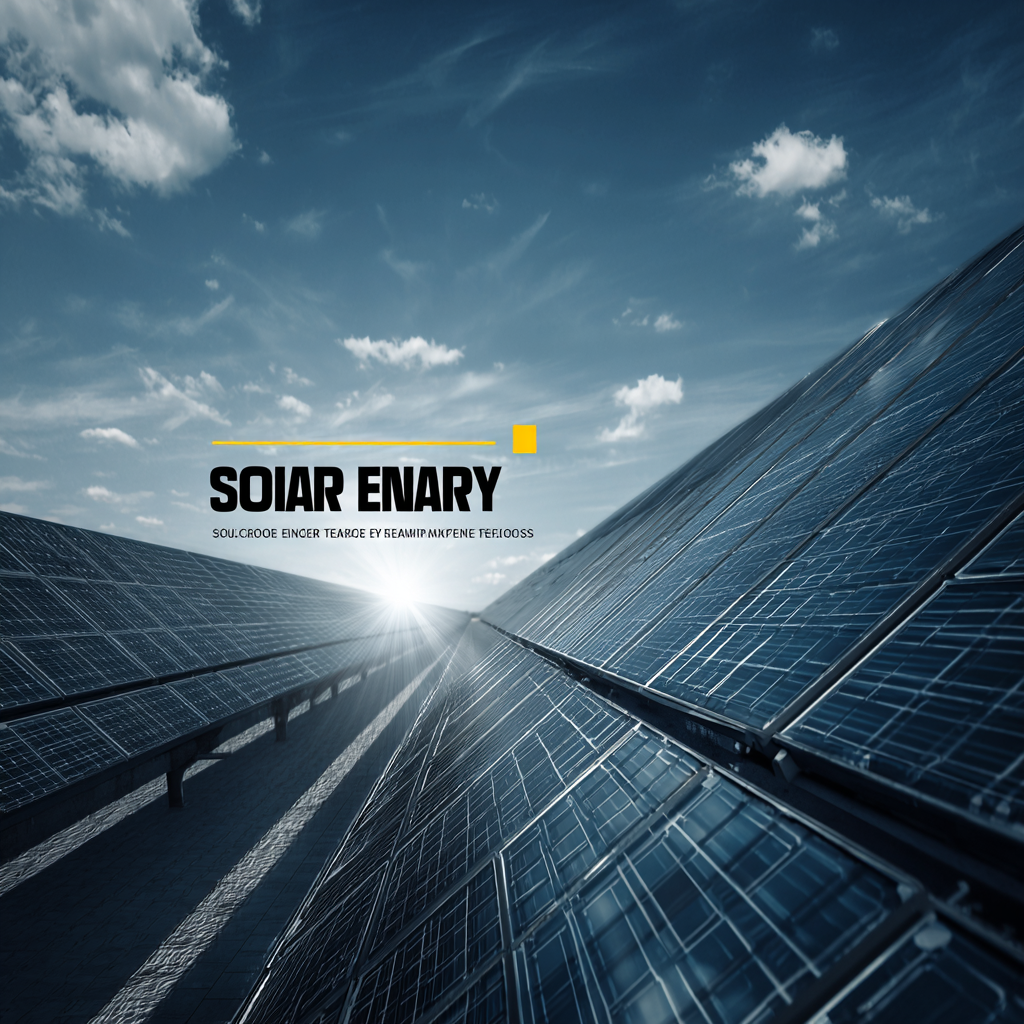Emerging Technologies Shaping the Future of Home Solar Energy Panels by 2025
The future of solar energy panels for home use is rapidly evolving, driven by emerging technologies that promise to enhance efficiency, affordability, and sustainability by 2025. According to a report by the International Energy Agency, the demand for residential solar installations is projected to grow by over 15% annually, as homeowners increasingly look for renewable energy solutions to combat rising energy costs and environmental concerns. Innovations such as photovoltaic materials that integrate seamlessly with roofing, energy storage systems with enhanced battery life, and smart technology for optimizing energy consumption are reshaping the landscape of home solar energy. As industry players continue to invest in research and development, the capabilities of solar energy panels for home applications are expanding, making them more accessible and efficient than ever before. This blog will explore these exciting advancements and their implications for the solar energy market.

Identifying the Key Features of High-Quality Solar Panel Manufacturers
The advancements in solar technology are continuously redefining the standards for high-quality solar panel manufacturers. As we look toward 2025, several emerging technologies are proving critical in shaping efficient solar energy solutions. One noteworthy development is the improved defect detection methods for photovoltaic modules, which ensure optimal performance and enhance power generation efficiency. Utilizing enhanced models like VarifocalNet, manufacturers can swiftly identify and replace defective modules, thus safeguarding energy output.
Tips: When choosing solar panels, prioritize those that utilize advanced defect detection technology, as this can significantly influence the longevity and efficiency of your solar investment. Additionally, consider panels that demonstrate high energy and exergy performance metrics, which reflect their effectiveness in converting sunlight into usable energy.

In parallel, the integration of machine learning for energy management is another key area for top manufacturers. These technologies aid in power forecasting and enable better-grid connections, ensuring that solar energy systems can adapt to varying energy demands. By focusing on these innovative features, consumers can better navigate the market and select products that not only meet current standards but are also equipped for future advancements in solar energy.
Tips: Look for manufacturers that actively innovate and incorporate AI in their energy management systems, as this can elevate the operational efficiency of your solar panels.
The Role of Innovative Materials in Solar Panel Efficiency and Durability
Innovative materials are set to revolutionize the efficiency and durability of solar panels by 2025, paving the way for a more sustainable energy future. Traditional silicon-based solar cells, while effective, are being complemented and even replaced by advanced materials such as perovskite and multilayer films. Perovskite solar cells, for instance, have shown remarkable potential, boasting a higher absorption rate and energy conversion efficiency that can exceed 25%. Their lightweight and flexible properties also allow for integration into a variety of surfaces, from building facades to windows, expanding the scope of solar energy capture.
Moreover, advancements in protective coatings and encapsulation technologies are enhancing the durability of solar panels. Innovative materials that resist environmental stresses—such as UV exposure, moisture, and extreme temperatures—are now being developed. These enhancements not only prolong the lifespan of solar panels but also reduce maintenance costs, making solar energy systems more appealing for homeowners. As these innovations continue to emerge, the solar industry is poised for significant transformation, offering more reliable and efficient energy solutions for residential use.
Emerging Technologies Shaping the Future of Home Solar Energy Panels by 2025
| Technology | Efficiency Improvement (%) | Durability (Years) | Cost Reduction (%) | Emerging Year |
|---|---|---|---|---|
| Perovskite Solar Cells | 30% | 20 | 50% | 2023 |
| Bifacial Solar Panels | 15% | 25 | 30% | 2024 |
| Transparent Solar Cells | 10% | 15 | 20% | 2025 |
| Solar Skin Technology | 12% | 30 | 25% | 2024 |
| AI Optimized Solar Systems | 20% | N/A | 60% | 2025 |
Evaluating Manufacturing Processes: What Sets the Best Apart
The manufacturing processes behind solar energy panels are evolving rapidly, with several key factors setting the best products apart in the competitive market. According to a 2023 report by the International Energy Agency (IEA), advances in automation and materials science are crucial in driving efficiency and lowering costs. Manufacturers that adopt innovative techniques, such as using bifacial solar cells, can enhance energy output by as much as 20%, giving them a significant edge in the market.
Tip: When evaluating solar panel options, prioritize manufacturers that utilize cutting-edge technology in their production processes. Look for certifications in sustainability and efficiency, as these can be indicative of a company's commitment to quality.
Moreover, supply chain management plays a pivotal role in the manufacturing landscape. Companies that streamline procurement and logistics can reduce lead times, lowering the final price for consumers. A 2022 report by Bloomberg New Energy Finance highlighted that effective supply chain strategies could decrease panel costs by up to 15%. This not only makes solar energy more accessible but also accelerates the transition to greener energy sources.
Tip: Research the supply chain practices of your potential solar panel provider. Transparency and reliability in sourcing materials can be a strong indicator of product durability and performance.

Emerging Technologies to Watch in Solar Panel Production by 2025
As the world shifts towards sustainable energy solutions, the solar panel industry is poised for transformative advancements by 2025. Among the most intriguing emerging technologies is the advent of bifacial solar panels. These innovative panels are designed to absorb sunlight from both sides, significantly increasing their energy generation efficiency. With this technology, it is projected that homeowners can enjoy higher energy yields, especially in areas with reflective surfaces such as water or light-colored roofs.
Another promising development is the integration of artificial intelligence (AI) in energy management systems. Smart monitoring solutions, powered by AI, will enable homeowners to optimize their energy consumption patterns, balancing solar energy production with usage. This could lead to smarter energy storage options, where AI algorithms predict energy needs, ensuring that homeowners maximize the benefits of their solar installations while reducing reliance on traditional energy sources.
The incorporation of perovskite solar cells is also expected to revolutionize solar panel production. These cells offer the potential for higher efficiency at lower manufacturing costs compared to traditional silicon-based solar cells. Perovskite technology is still in its nascent stages, but by 2025, it could lead to thinner, lighter, and more flexible panels, making solar energy more accessible for various residential applications. This evolving landscape of solar technology promises to enhance sustainability and efficiency, setting the stage for a greener future in energy consumption.
Emerging Technologies Shaping the Future of Home Solar Energy Panels by 2025
Solutions for Enhancing Solar Power Adoption in Residential Homes
As we look toward 2025, the adoption of solar power in residential homes is poised to receive a significant boost through innovative technologies. One major solution is the advancement of solar panel efficiency. New materials, such as perovskite, are being developed to offer higher energy conversion rates at a lower cost. This transformation makes solar energy not only more accessible but also more appealing to homeowners who may have been hesitant due to traditional pricing and performance parameters.
Another crucial factor in accelerating solar power acceptance is the integration of smart home technology. Homeowners are increasingly turning to energy management systems that can optimize power usage and storage. By combining solar panels with intelligent battery systems, residents can harness energy during peak sun hours and utilize it when demand is higher, thus maximizing utility savings. Furthermore, educational initiatives aimed at informing communities about the long-term benefits and incentives associated with solar energy are vital in fostering a culture of sustainability and encouraging the transition to renewable energy sources.